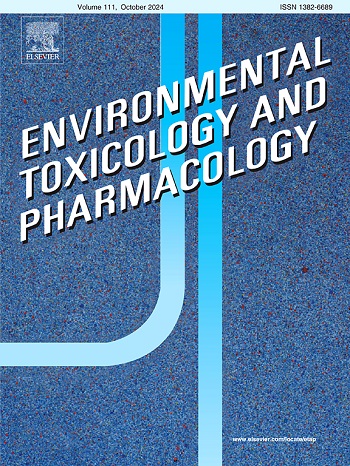评估钆污染对海洋双壳类动物 Donax trunculus 的影响:对环境健康的影响。
IF 4.2
3区 环境科学与生态学
Q2 ENVIRONMENTAL SCIENCES
引用次数: 0
摘要
钆(Gd)常用于医学成像造影剂,在医院废水和水生环境中被检测到,引起了环境问题。这项研究考察了钆在蛤类物种 Donax trunculus 中的积累和对细胞的影响。钆在蛤蜊体内的积累随着接触时间的延长而增加。生物反应随 Gd 含量而变化:低浓度(10 和 50 微克/升)导致代谢活性和糖原含量低,但抗氧化活性和脂质过氧化水平(LPO)高;高浓度(250 和 500 微克/升)导致代谢活性增加,而抗氧化酶活性受到抑制,LPO 水平最低。新陈代谢活性在两周后下降,表明长期新陈代谢恢复能力有限。该研究强调了三疣梭子蟹是钆污染的有效预警物种,并突出了钆含量上升的生态风险,强调了环境监测和监管的必要性。本文章由计算机程序翻译,如有差异,请以英文原文为准。
Evaluating the impact of gadolinium contamination on the marine bivalve Donax trunculus: Implications for environmental health
Gadolinium (Gd), commonly used in contrast agents for medical imaging, has been detected in hospital wastewater and aquatic environments, raising environmental concerns. This study examined the accumulation and cellular impacts of Gd in the clam species Donax trunculus, commonly used as bioindicator of contamination. Gadolinium accumulation in clams increased with exposure and over time. Biological responses varied with Gd levels: low concentrations (10 and 50 µg/L) led to low metabolic activity and glycogen content, but high antioxidant activities and lipid peroxidation levels (LPO); high concentrations (250 and 500 µg/L) resulted in increased metabolic activity, while antioxidant enzyme activity was inhibited and LPO levels were the lowest. Metabolic activity decreased after two weeks, suggesting limited long-term metabolic resilience. The study underscores D. trunculus as an effective early warning species for Gd pollution and highlights the ecological risks of rising Gd levels, emphasizing the need for environmental monitoring and regulation.
求助全文
通过发布文献求助,成功后即可免费获取论文全文。
去求助
来源期刊
CiteScore
7.00
自引率
4.70%
发文量
185
审稿时长
34 days
期刊介绍:
Environmental Toxicology and Pharmacology publishes the results of studies concerning toxic and pharmacological effects of (human and veterinary) drugs and of environmental contaminants in animals and man.
Areas of special interest are: molecular mechanisms of toxicity, biotransformation and toxicokinetics (including toxicokinetic modelling), molecular, biochemical and physiological mechanisms explaining differences in sensitivity between species and individuals, the characterisation of pathophysiological models and mechanisms involved in the development of effects and the identification of biological markers that can be used to study exposure and effects in man and animals.
In addition to full length papers, short communications, full-length reviews and mini-reviews, Environmental Toxicology and Pharmacology will publish in depth assessments of special problem areas. The latter publications may exceed the length of a full length paper three to fourfold. A basic requirement is that the assessments are made under the auspices of international groups of leading experts in the fields concerned. The information examined may either consist of data that were already published, or of new data that were obtained within the framework of collaborative research programmes. Provision is also made for the acceptance of minireviews on (classes of) compounds, toxicities or mechanisms, debating recent advances in rapidly developing fields that fall within the scope of the journal.

 求助内容:
求助内容: 应助结果提醒方式:
应助结果提醒方式:


